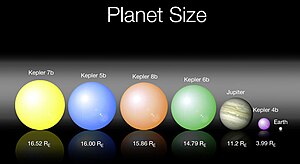开普勒4
| 观测资料 历元 J2000.0 | |
|---|---|
| 星座 | 天龙座 |
| 星官 | |
| 赤经 | 19h 2m 27.68s[1] |
| 赤纬 | +50° 8′ 8.7″[1] |
| 视星等(V) | 12.6 |
| 特性 | |
| 光谱分类 | G0 |
| U−B 色指数 | ? |
| B−V 色指数 | ? |
| V−R 色指数 | ? |
| R−I 色指数 | ? |
| 变星类型 | none |
| 天体测定 | |
| 距离 | 1631 ly (550 pc) |
| 详细资料 | |
| 质量 | 1.223 M☉ |
| 半径 | 1.487 R☉ |
| 亮度 | 0.354±0.1 L☉ |
| 温度 | 5857 K |
| 年龄 | 4.5 Gyr |
| 其他命名 | |
开普勒4(英语:Kepler-4),是一颗位于天龙座的G5V型类太阳恒星,距离地球约1631光年。这颗恒星是由开普勒太空望远镜发现的。于2010年,开普勒太空望远镜发现开普勒4拥有一颗非常接近母星的行星,开普勒4b[2]。美国航空航天局于2010年1月4日公布这个发现。开普勒4b是开普勒太空望远镜发现的首五个系外行星之一,亦是其中体积和质量最小的行星。
命名和历史
[编辑]
开普勒4是开普勒太空望远镜发现的第四颗恒星,因此得名“开普勒4”。[3]而因为前三个被开普勒太空望远镜发现的恒星皆早已被其他天文学家发现,因此开普勒4其实是首个被开普勒太空望远镜首次发现的恒星。[4]美国航空航天局于2010年1月4日在华盛顿哥伦比亚特区美国天文学会第215次会议宣布他们发现了开普勒4、开普勒5、开普勒6、开普勒7和开普勒8。在被公布的行星中,大部分行星的规模皆与木星相若,唯独是开普勒4b的规模仅与海王星相若,是被公布行星中规模最小的一个。[5]开普勒太空望远镜发现开普勒4b一事证实了开普勒太空望远镜的实用性高。[6]
德克萨斯州大学奥斯汀分校的天文学家们透过使用位于美国德克萨斯州戴维斯堡麦克唐纳天文台的哈伦·J·史密斯望远镜,确认了开普勒4b的存在。[7]天文学家们亦使用了位于夏威夷、加利福尼亚州、亚利桑那州和加那利群岛的望远镜来确认这个发现。[6]
恒星状况
[编辑]开普勒4是一颗类太阳恒星,其恒星光谱分类为G0。其质量为太阳质量的1.223倍,而半径则为太阳半径的1.487倍。这代表开普勒7比太阳重22%,并且比太阳阔48%。这颗星的表面重力为4.6527 ± 0.0017 cgs。这颗星的估计年龄为45 ± 15 亿年。[8]这颗星的估计金属量为[Fe/H] = 17 ± 0.06,比太阳的金属丰度多48%。而有效温度则为5857 ± 120 K。相比而言,太阳的年龄为45.7亿年[9],有效温度仅为5778 K[10],金属量为[Fe/H] = 0.0122。[11]
开普勒4的视星等为12.7,代表人类肉眼是看不见这颗星的,必须以望远镜观测。这颗联星估计距离地球1631光年(550秒差距)。[8]
行星系统
[编辑]
开普勒4至今已知只有一个行星,开普勒4b。该行星是于2010年1月4日被发现的,其规模与海王星相若,质量为木星质量的0.077倍,半径为木星半径的0.357倍。其半长轴长0.045 AU,轨道周期为3.214天。[4]这个距离为水星半长轴的12%(水星的半长轴长0.39 AU)。[12]这显示开普勒4b是一个热海王星。开普勒4b的轨道离心率被假设为0,但后来的测量显示其轨道离心率为0.25 ± 0.12。[13]其表面温度达1650 K,比海王星的表面温度(72 K)要高得多。[4]
| 成员 (依恒星距离) |
质量 | 半长轴 (AU) |
轨道周期 (天) |
离心率 | 倾角 | 半径 |
|---|---|---|---|---|---|---|
| b | 0.077 MJ | 0.04558 | 3.2135 | 0.25 ± 0.12 | 89.76° | 0.357 RJ |
参考资料
[编辑]- ^ 1.0 1.1 Borucki, William J.; et al. Kepler-4b: A Hot Neptune-like Planet of a G0 Star Near Main-sequence Turnoff. The Astrophysical Journal Letters. 2010, 713 (2): L126 [2013-12-07]. Bibcode:2010ApJ...713L.126B. arXiv:1001.0604
 . doi:10.1088/2041-8205/713/2/L126. (原始内容存档于2019-12-13).
. doi:10.1088/2041-8205/713/2/L126. (原始内容存档于2019-12-13).
- ^ Summary Table of Kepler Discoveries. NASA. 2010-01-04 [2010-01-06].[永久失效链接]
- ^ Kepler: About the Mission. Kepler Mission. NASA. 2011 [24 February 2011]. (原始内容存档于2012-05-08).
- ^ 4.0 4.1 4.2 4.3 Summary Table of Kepler Discoveries. NASA. 2010-08-27 [2010-10-16]. (原始内容存档于2017-04-01).
- ^ Rich Talcott. 215th AAS meeting update: Kepler discoveries the talk of the town. Astronomy.com. Astronomy magazine. 5 January 2010 [24 February 2011]. (原始内容存档于2011-07-18).
- ^ 6.0 6.1 NASA's Kepler Space Telescope Discovers its FIrst Five Exoplanets. NASA. 4 January 2010 [25 February 2011]. (原始内容存档于2012-04-15).
- ^ Texas Astronomers Aid Kepler Mission's Discovery of New Planets. UT News. University of Texas at Austin. 4 January 2010 [25 February 2011]. (原始内容存档于2011-06-28).
- ^ 8.0 8.1 Jean Schneider. Planet Kepler-4 b. Extrasolar Planets Encyclopaedia. Jean Schneider. 2010 [5 August 2012]. (原始内容存档于2019-05-19).
- ^ Fraser Cain. How Old is the Sun?. Universe Today. 16 September 2008 [25 February 2011]. (原始内容存档于2010-08-18).
- ^ David Williams. Sun Fact Sheet. Goddard Space Flight Center. NASA. 1 September 2004 [27 February 2011]. (原始内容存档于2010-07-15).
- ^ Asplund, M.; N. Grevesse and A. J. Sauval. The new solar abundances - Part I: the observations. Communications in Asteroseismology. 2006, 147: 76–79. Bibcode:2006CoAst.147...76A. doi:10.1553/cia147s76.
- ^ David Williams. Mercury Fact Sheet. Goddard Space Flight Center. NASA. 17 November 2010 [25 February 2011]. (原始内容存档于2014-03-28).
- ^ 13.0 13.1 Kipping, David; Bakos, Gáspár. An Independent Analysis of Kepler-4b through Kepler-8b. The Astrophysical Journal. 2011, 730 (1). 50 [2013-12-07]. Bibcode:2011ApJ...730...50K. arXiv:1004.3538
 . doi:10.1088/0004-637X/730/1/50. (原始内容存档于2019-12-13).
. doi:10.1088/0004-637X/730/1/50. (原始内容存档于2019-12-13).
Text is available under the CC BY-SA 4.0 license; additional terms may apply.
Images, videos and audio are available under their respective licenses.
